Reviewed by Dr. Fiona Lee
As loving pet parents, we often share everything with our furry companions, from our beds to our joyful moments. However, when it comes to food, what’s good for humans isn’t always good for dogs. In fact, some common household foods can be extremely dangerous, even fatal, for your beloved canine. Understanding what food dogs can’t have is crucial for their safety and well-being. This guide from Dog Care Story, your trusted resource for pet care, will delve into the critical topic of toxic foods for dogs, providing you with a comprehensive “cheat sheet” to help protect your loyal companion.
The threat of pet poisoning from common household foods is more prevalent than many realize. Statistics show that hundreds of thousands of pet poisonings occur annually in the United States alone. While not all are food-related, everyday human foods are significant contributors. Therefore, being well-informed about foods your dog should avoid, and conversely, what food should I be feeding my dog for optimal health, is an essential part of responsible dog ownership. This article aims to empower you with the knowledge to make safe dietary choices for your dog, ensuring they live a happy and healthy life free from preventable food-related hazards.
Why Certain Foods Are Toxic to Dogs
A fundamental question many pet owners ask is, “what can dogs eat and not eat?” The answer lies in the distinct differences between canine and human digestive systems and metabolic processes. Dogs’ bodies are simply not equipped to process certain substances in the same way ours are, making many seemingly harmless human foods potentially toxic to them.
For instance, theobromine and caffeine, compounds found in chocolate, are metabolized much slower by dogs than by humans. This delayed processing allows these substances to accumulate rapidly in a dog’s system, leading to severe illness and potentially fatal consequences. Similarly, while cherries are a common and safe human fruit, their pits, stems, and leaves contain cyanide. Although small amounts might not be immediately lethal, ingesting large quantities can be problematic. Furthermore, the hard pits themselves can cause gastrointestinal obstruction and diarrhea due to difficulty in digestion, making it best to avoid them altogether.
Food toxicity can also vary significantly based on a dog’s individual characteristics, including their size, breed, and overall health condition. A tiny toy breed might react severely to an amount of a toxic substance that a large breed could tolerate (though still not recommended). Dogs with pre-existing conditions or compromised immune systems may also be more vulnerable. This is precisely why consulting your veterinarian is paramount if you have any doubts about what food dogs can’t have or if your dog has ingested something questionable. Your vet can provide tailored advice based on your dog’s specific needs and health profile.
List of Common Foods Dogs Cannot Eat
Many household foods pose a serious danger, often being outright toxic, to dogs. While some of the most widely known offenders include alcohol, avocados, macadamia nuts, grapes, raisins, xylitol, and chocolate, this is not an exhaustive list. It is vital for your dog’s safety to be aware of all the foods listed below and understand why they are harmful. Remember, when in doubt about what food dogs can’t have, it’s always best to err on the side of caution and avoid feeding it.
 Dog looking at a glass of red wine, illustrating why alcohol is one of the foods dogs can't have
Dog looking at a glass of red wine, illustrating why alcohol is one of the foods dogs can't have
1. Alcohol
Due to their smaller body size and differing metabolic rates compared to humans, even minimal amounts of alcohol can have a deadly effect on dogs. The smaller the pet, the greater the danger posed by even a small quantity of alcohol. Symptoms of alcohol poisoning in dogs mirror those in humans, including vomiting, significant breathing difficulties, disorientation, coma, and even death. It’s crucial to keep all alcoholic beverages and products containing alcohol completely out of your dog’s reach.
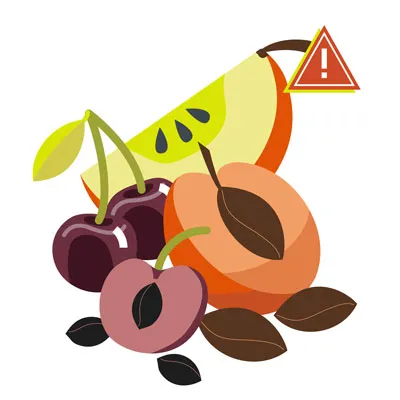 Close-up of apple slices with visible seeds, highlighting the danger of fruit pits and seeds for dogs
Close-up of apple slices with visible seeds, highlighting the danger of fruit pits and seeds for dogs
2. Apple, Apricot, Cherry, & Plum Seeds/Pits
While the fleshy parts of apples are generally safe for dogs when served without the core and seeds, the seeds themselves are not. Apple seeds contain cyanide, and though small amounts might not immediately cause problems, it’s safest to avoid the core and seeds entirely. The pits and seeds of apricots, cherries, peaches, and plums should also be strictly avoided. These fruit pits also contain cyanide, which can lead to severe symptoms such as vomiting, an irregular and rapid heartbeat, seizures, coma, and ultimately death. This toxicity arises from the cyanide’s interference with red blood cells’ ability to properly transport oxygen to the body’s cells.
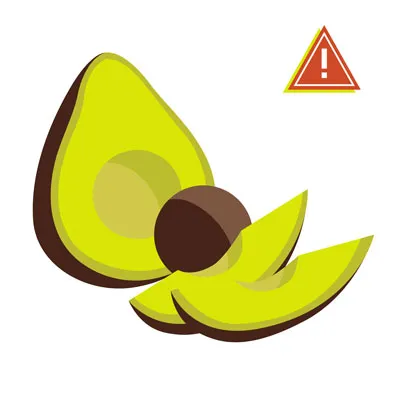 Sliced avocado, a food dogs cannot safely consume due to potential health risks
Sliced avocado, a food dogs cannot safely consume due to potential health risks
3. Avocado
Avocados are generally not a good food choice for dogs. While the highly publicized cases of avocado toxicity in dogs leading to myocardial damage (heart muscle damage) haven’t been widely replicated, avocados are known to cause issues in other mammal species. More importantly, an intact avocado pit, if ingested, can cause a dangerous gastrointestinal obstruction, requiring emergency veterinary intervention. Given these potential risks, it is best to completely avoid feeding avocado to your dog.
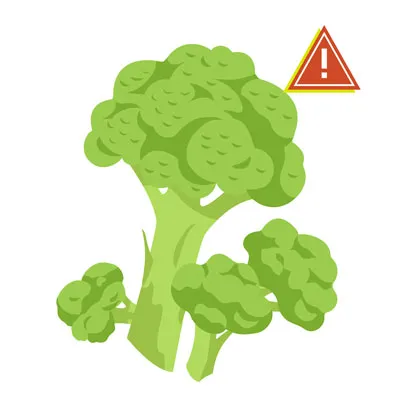 Fresh broccoli florets, a food that should be avoided in large quantities by dogs
Fresh broccoli florets, a food that should be avoided in large quantities by dogs
4. Broccoli
Broccoli contains isothiocyanates, compounds that, in very large doses, can be harmful to pets. While small, occasional amounts of broccoli might be tolerated by some dogs, it is generally best to avoid them due to the availability of so many other genuinely healthy and safe alternatives. Additionally, the fibrous stalks of broccoli can pose a choking hazard or become lodged in a dog’s throat, leading to an obstruction that requires immediate attention.
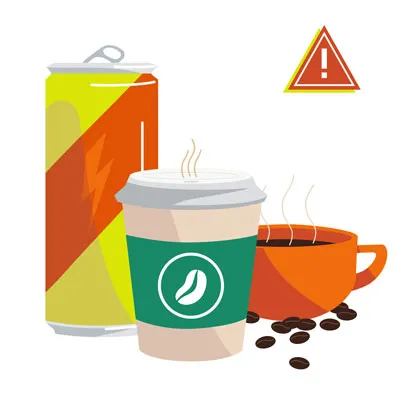 Coffee beans and ground coffee, sources of caffeine toxic to dogs
Coffee beans and ground coffee, sources of caffeine toxic to dogs
5. Caffeine and Coffee Grounds
Caffeine is a potent stimulant that contains methylxanthines, which are highly toxic to dogs. Ingesting caffeine can lead to potentially fatal symptoms such as severe diarrhea, vomiting, seizures, and an irregular heartbeat. Even small amounts, like those found in coffee grounds, tea bags, or energy drinks, can cause your dog’s heart to race, leading to tremors, arrhythmia, difficulty breathing, and other life-threatening symptoms. Ensure all caffeine-containing products are securely stored away from your pet.
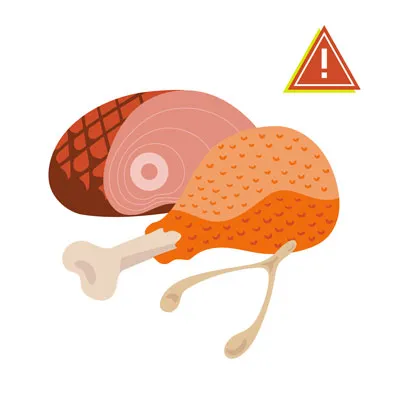 Fatty cooked meat, such as chicken skin and ham, which can cause pancreatitis in dogs
Fatty cooked meat, such as chicken skin and ham, which can cause pancreatitis in dogs
6. Chicken & Turkey Skin, Ham, & Other Fatty Cuts of Meat
When considering what food dogs can’t have, high-fat items like chicken or turkey skin, ham, and other fatty cuts of meat are definite no-gos. These foods are dangerous for dogs due to their excessive fat content, which can trigger acute pancreatitis. Pancreatitis is a severe, life-threatening inflammatory condition of the pancreas that can lead to complicated health issues and requires intensive veterinary care.
Furthermore, you should also avoid turkey and chicken bones. Cooked bones are particularly brittle and can splinter easily, causing internal damage. These splinters can obstruct the bowels or puncture the stomach or intestines, potentially leading to fatal abdominal infections. Even raw bones carry risks of choking or internal injury.
 Assortment of chocolate pieces, a highly toxic food for dogs
Assortment of chocolate pieces, a highly toxic food for dogs
7. Chocolate
Chocolate toxicity is one of the most well-known and frequent causes of pet poisoning. Your dog absolutely cannot eat any chocolate product. Chocolate contains a compound called theobromine, which is lethal to dogs; the darker and more bitter the chocolate, the higher its concentration of theobromine. Chocolate also contains caffeine, and some sugar-free chocolates may additionally contain xylitol, both of which are highly toxic to dogs.
Dogs and cats cannot metabolize chocolate effectively, allowing these toxic substances to build up rapidly in their systems. Dark chocolate and baker’s chocolate are the most dangerous, but any type of chocolate, in sufficient quantity, can be problematic. Symptoms associated with chocolate ingestion can include hyperactivity, vomiting, diarrhea, pancreatitis, abnormal heart rhythms, and seizures. If your dog ingests any amount of chocolate, no matter how small, contact your veterinarian immediately for guidance.
 Fresh red and green grapes, known to cause kidney failure in dogs
Fresh red and green grapes, known to cause kidney failure in dogs
8. Grapes and Raisins
Grapes and raisins are extremely dangerous to dogs. These seemingly innocent fruits can cause severe kidney failure, primarily due to their tartaric acid content, which is toxic to a dog’s kidneys. Even a few bites can wreak havoc on your dog’s system. Symptoms of raisin or grape poisoning include vomiting and diarrhea, a significant loss of appetite, lethargy, abdominal pain, changes in the amount of urine passed (either increased or decreased), or a complete inability to pass urine. Immediate veterinary attention is critical if ingestion is suspected.
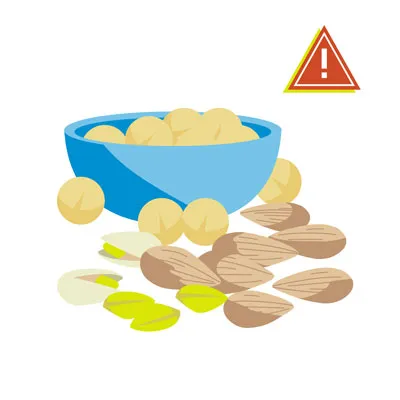 Bowl of macadamia nuts, a common food dogs can't have due to toxicity
Bowl of macadamia nuts, a common food dogs can't have due to toxicity
9. Macadamia Nuts, Almonds, & Pistachios
Macadamia nuts are particularly problematic for dogs, capable of causing a range of painful symptoms including weakness, hind leg paralysis, joint pain, tremors, overheating, and vomiting. While the precise mechanism of poisoning remains somewhat mysterious, these nuts are definitively considered toxic to dogs. As few as six macadamia nuts can induce severe poisoning in a small dog.
While macadamia nuts are the most acutely dangerous, other nuts like pistachios and almonds can also be problematic. They pose choking hazards, especially for smaller dogs, and can cause gastrointestinal upset due to their high fat content. Additionally, flavored or spiced nuts often contain harmful ingredients like salt, garlic, or onion powder, making them even more dangerous. Always keep nuts out of your dog’s reach.
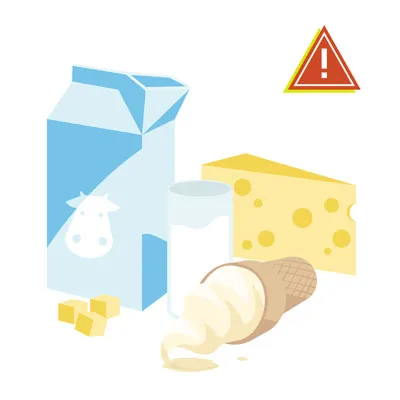 Glass of milk and a cheese slice, dairy products that can cause digestive upset in some dogs
Glass of milk and a cheese slice, dairy products that can cause digestive upset in some dogs
10. Milk and Dairy Products
The safety of milk and other dairy products for dogs is highly individualized and should be considered on a case-by-case basis. Some dogs can consume small amounts of milk or certain dairy products without issue. However, many dogs are lactose intolerant or have dairy allergies, and for them, ingesting cow’s milk or dairy can lead to uncomfortable symptoms like diarrhea, gas, and stomach upset.
Ice cream, while a popular human treat, is generally bad for dogs due to its high sugar and fat content, which can contribute to weight gain and pancreatitis. Instead of ice cream, consider freezing bites of healthy, dog-safe fruits as a refreshing alternative. As for cheese, small quantities may be acceptable as an occasional treat, but it’s best to stick to lower-fat varieties to minimize the risk of digestive upset or pancreatitis. Always observe your dog for any adverse reactions after introducing new foods.
 Wild mushrooms in a forest, emphasizing the danger of unknown mushroom varieties to dogs
Wild mushrooms in a forest, emphasizing the danger of unknown mushroom varieties to dogs
11. Mushrooms
When it comes to mushrooms, it’s always best to err on the side of extreme caution and avoid feeding them to your dog. Wild mushrooms, in particular, can contain a wide variety of toxins that may cause severe health problems, including kidney and liver failure, severe vomiting and diarrhea, hallucinations, and damage to red blood cells. Even store-bought white button mushrooms, though generally considered non-toxic when washed and cooked, are probably safer to avoid, given the numerous healthy and unequivocally safe treats available for your dog. If your dog ingests any wild mushrooms, seek immediate veterinary care as identification can be difficult and symptoms can be severe.
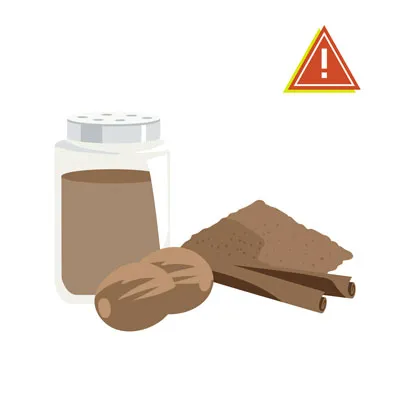 Ground nutmeg and cinnamon sticks, spices that are harmful to dogs
Ground nutmeg and cinnamon sticks, spices that are harmful to dogs
12. Nutmeg and Cinnamon
Dogs should never be fed any foods containing nutmeg. This spice contains myristicin, a compound that can cause severe vomiting, disorientation, and even hallucinations in dogs. The effects are typically more pronounced with high doses or in smaller dog breeds. If your dog ingests any amount of nutmeg, contact your veterinarian promptly for advice.
Cinnamon, while not considered directly toxic, should also be avoided. Ingesting cinnamon powder can irritate your dog’s mouth and digestive tract, leading to discomfort. In larger quantities, or if ingested in concentrated forms (like essential oils), cinnamon can potentially lead to low blood sugar, which can have serious health implications for your pup, including weakness, vomiting, and even liver damage.
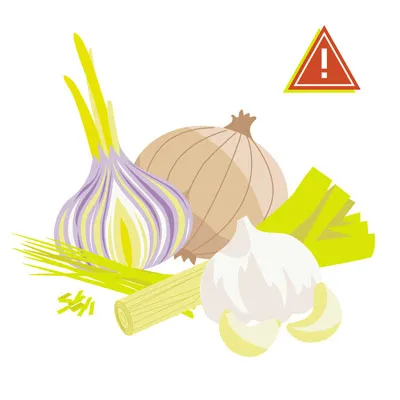 A selection of allium vegetables including onions and garlic, which are toxic to dogs
A selection of allium vegetables including onions and garlic, which are toxic to dogs
13. Onions, Garlic, Chives, & Leeks
Many pet owners are surprised to learn that herbs and vegetables belonging to the allium family—such as onions, garlic, chives, and leeks—are not safe for their canine companions. These plants contain sulfoxides and disulfides, compounds that can damage a dog’s red blood cells, leading to a dangerous condition known as anemia. Symptoms of allium poisoning can include lethargy, weakness, pale gums, vomiting, diarrhea, and dark urine.
It’s particularly important to be aware that onion and garlic powders are frequently found in many prepared human foods, including sauces, baby food, and processed snacks. Always make sure to carefully read ingredient labels before offering any store-bought food to your pet. All allium plants, regardless of variety, can cause potentially fatal anemia in dogs and cats. Certain Japanese breeds, such as Akitas and Shiba Inus, are known to be particularly sensitive to allium plants, but these foods are dangerous to all dogs. If your dog has a sensitive stomach and is not eating, do not offer these harmful foods as a substitute.
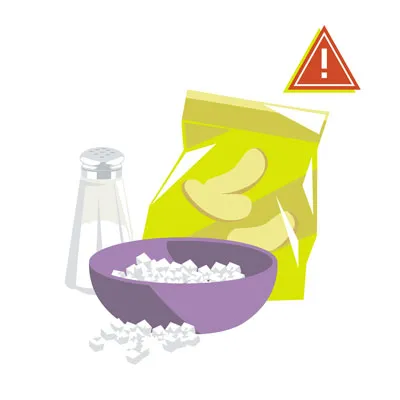 A pile of white salt crystals, indicating that excessive salt intake is bad for dogs
A pile of white salt crystals, indicating that excessive salt intake is bad for dogs
14. Salt
Excessive amounts of salt (sodium chloride) can be highly detrimental to your dog’s health. Too much salt can disrupt the delicate fluid balance of cells in your dog’s body, leading to a condition called sodium ion poisoning. Symptoms can include tremors, seizures, vomiting, diarrhea, lethargy, excessive thirst or urination, and in severe cases, kidney damage, coma, or even death. Whether it’s rock salt, homemade play dough (which often contains high amounts of salt), or salty snacks like potato chips, never let your dog’s pleading eyes jeopardize their health. Always ensure your dog has access to plenty of fresh water, especially if they’ve accidentally ingested a small amount of salt.
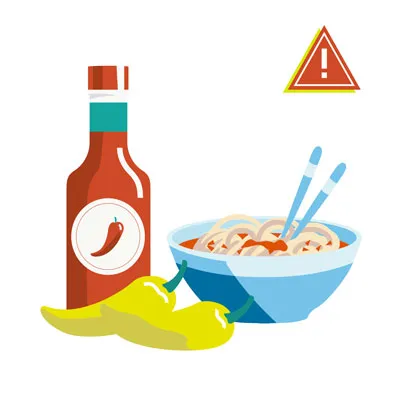 Red chili peppers, representing spicy foods that can cause stomach upset in dogs
Red chili peppers, representing spicy foods that can cause stomach upset in dogs
15. Spicy Food
Keep your canine companion far away from spicy human foods. Hot and spicy ingredients like chili peppers, cayenne, or jalapeños can cause significant gastrointestinal distress in dogs. This can manifest as severe vomiting, painful stomach ulcers, or prolonged bouts of diarrhea, leading to dehydration and discomfort for your dog. Such incidents can also result in expensive emergency veterinary visits. It’s best to stick to bland, dog-appropriate treats to avoid any unnecessary pain or medical complications.
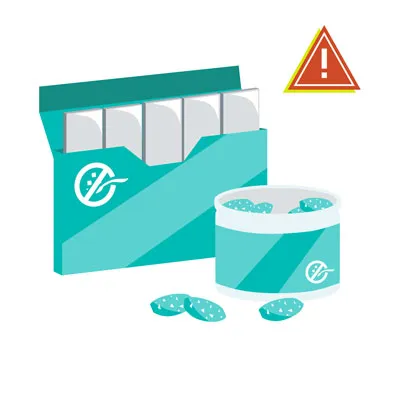 Sugar-free gum and candies, often containing xylitol which is highly toxic to dogs
Sugar-free gum and candies, often containing xylitol which is highly toxic to dogs
16. Sugar-Free Gum & Candy (Xylitol)
Xylitol is a common artificial sweetener found in a wide array of human foods, including sugar-free gum, candy, baked goods, toothpaste, and even some peanut butters. However, in dogs, xylitol is profoundly toxic and can cause a rapid and dangerous drop in blood sugar (hypoglycemia) that leads to profound weakness, loss of coordination, and even seizures. Some dogs may also develop severe liver failure, which can be fatal.
Dog poisoning cases involving this artificial sweetener are unfortunately on the rise. A tragically small amount can be deadly; for instance, the xylitol content in just five pieces of sugar-free gum has the potential to kill a 65-pound dog. Always check ingredient labels for xylitol before sharing any human food or product with your dog. If your dog gets into sugar-free items, contact an emergency vet immediately. If your dog is a picky eater, ensure any treats you offer are specifically made for dogs and free of xylitol.
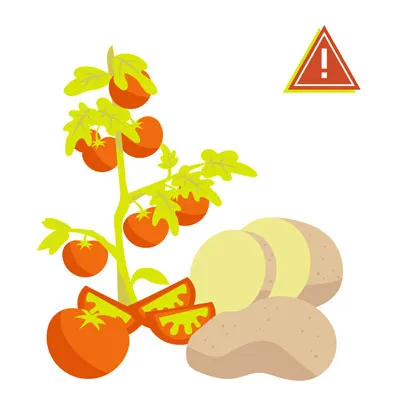 Green tomatoes and raw potatoes, plant parts containing solanine that are harmful to dogs
Green tomatoes and raw potatoes, plant parts containing solanine that are harmful to dogs
17. Tomatoes and Raw Potatoes
Tomatoes and potatoes fall into the category of foods that are “safe in some forms, unsafe in others.” A fully ripened, red tomato is generally considered safe for dogs in moderation. However, the green parts of the tomato plant, including the leaves, stems, and unripe green tomatoes, contain solanine, a toxic compound for dogs.
Similarly, cooked potatoes (baked or boiled, without additives like butter, salt, or spices) are generally safe in small amounts. However, raw potatoes also contain solanine, particularly in their green parts or sprouts, making them toxic to dogs. Always ensure any potatoes offered to your dog are fully cooked and plain, and avoid any green or sprouting parts.
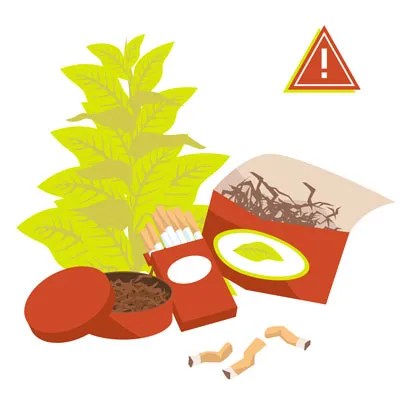 Cigarettes and tobacco leaves, highlighting nicotine products as dangerous for dogs
Cigarettes and tobacco leaves, highlighting nicotine products as dangerous for dogs
18. Tobacco
Tobacco, in any form, is incredibly dangerous and unhealthy for your dog. Exposure to nicotine-containing products such as cigarettes, cigars, chewing tobacco, nicotine patches, and e-cigarettes can cause a wide range of severe symptoms. These include vomiting, diarrhea, rapid or labored breathing, agitation, abnormal heart rate, wobbliness, muscle weakness, high or low blood pressure, seizures, and tremors. More significant or frequent exposure can lead to blue gums, collapse, coma, and can ultimately be fatal.
Dogs are naturally curious and may ingest discarded cigarettes found on a walk or sniff through an ashtray containing cigarette butts. If your dog ingests any tobacco product, you must act swiftly and take them to a veterinarian for emergency treatment right away. Time is of the essence in such cases.
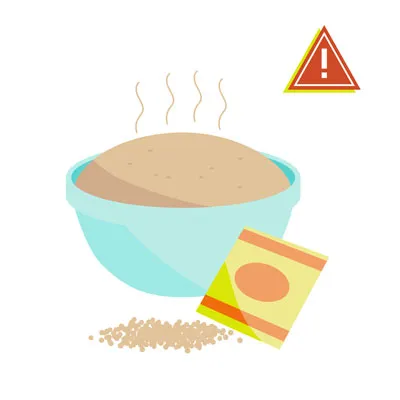 Bowl of raw dough rising, dangerous for dogs due to expansion and alcohol toxicity
Bowl of raw dough rising, dangerous for dogs due to expansion and alcohol toxicity
19. Yeast and Raw Dough
Yeast and raw dough are unsafe for dogs for multiple critical reasons. Firstly, raw dough, especially bread dough, can expand significantly in your dog’s warm stomach, causing severe pain, bloating, and potentially life-threatening gastric torsion (bloat) or rupture of the stomach. This requires immediate veterinary intervention.
Secondly, the yeast and sugar present in raw dough can ferment in the warm, moist environment of your dog’s stomach, producing ethanol. This leads to alcohol toxicity, which can rapidly become fatal and necessitates urgent medical attention. Symptoms of alcohol toxicity from raw dough include disorientation, vomiting, abdominal pain, bloat, and weakness. If your dog accidentally consumes raw dough, contact your veterinarian or an emergency animal hospital without delay.
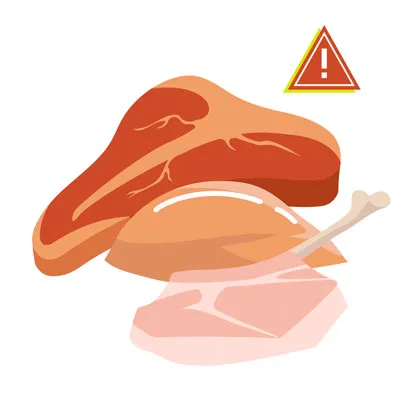 Raw chicken pieces, illustrating the risks of bacterial contamination and bones for dogs
Raw chicken pieces, illustrating the risks of bacterial contamination and bones for dogs
20. Raw Meat
Never feed your dog raw or undercooked meat. While some advocates promote raw food diets, the consensus among veterinary professionals is that raw meat carries significant risks. The possible presence of harmful bacteria like Salmonella, E. coli, Listeria, or Campylobacter, which are sometimes found in raw meat, can cause severe gastrointestinal illness in dogs, just as they can in humans. These pathogens can also be shed in your dog’s feces, posing a risk to other pets and family members. Additionally, raw meat often contains bones, which can cause choking, obstruct the digestive tract, or splinter and cause internal damage. Always cook meat thoroughly before offering it to your dog.
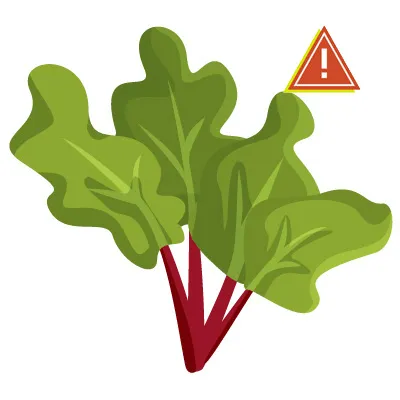 Fresh rhubarb stalks, a plant that is toxic to dogs due to oxalate crystals
Fresh rhubarb stalks, a plant that is toxic to dogs due to oxalate crystals
21. Rhubarb
Rhubarb, a plant commonly used in human desserts like pies, is not safe for pets. Its leaves contain high concentrations of soluble calcium oxalate crystals. If ingested in sufficiently large quantities, these crystals can bind with calcium in your dog’s body, causing a dangerous and rapid drop in blood calcium levels. This can lead to serious health complications, including kidney failure, and can even be life-threatening. Symptoms of rhubarb poisoning include tremors, weakness, excessive drooling, bloody urine, noticeable changes in thirst and urination, and vomiting.
 Sliced star fruit, a beautiful but harmful fruit for dogs due to calcium oxalate
Sliced star fruit, a beautiful but harmful fruit for dogs due to calcium oxalate
22. Star Fruit
Similar to rhubarb, star fruit (also known as carambola) also contains soluble calcium oxalate crystals. For this reason, you should not allow your dog to snack on this fruit. While an occasional tiny piece might not cause immediate harm, repeated or large ingestions can lead to the same kidney-related issues as rhubarb, especially in dogs with pre-existing kidney conditions. It’s safer to avoid this fruit entirely and choose other known safe options.
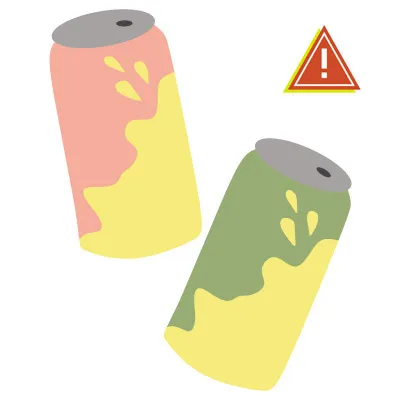 Glass of seltzer water with lime, a beverage not recommended for dogs
Glass of seltzer water with lime, a beverage not recommended for dogs
23. Flavored Water and Seltzer Water
It’s always best to err on the side of caution and give your dog only fresh, clean tap water rather than anything flavored or carbonated. Seltzer water and flavored waters can contain added ingredients that are dangerous for pups, including artificial sweeteners (like xylitol), high levels of sugar, or excessive salt. Plain seltzer water might be acceptable in very small, urgent amounts if no other water is available, but it can still lead to uncomfortable gas and bloating. The safest and healthiest option for your dog’s hydration is always plain, clean water.
13 Foods Safe for Dogs
While the list of what food dogs can’t have is extensive, rest assured that the list of safe foods for dogs is equally robust! Many human foods can be enjoyed by your canine companion in moderation and with proper preparation. Some of the most popular and safest options that dogs often love include small amounts of dehydrated chicken or beef (plain), apples (without the core and seeds), green beans, and carrots.
Here are some popular human foods that your dog can safely enjoy as treats. This list is not exhaustive, but it provides a great starting point for healthy snacking.
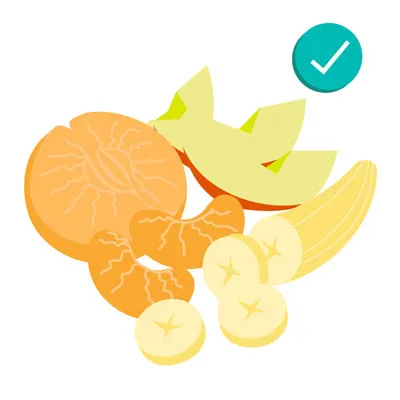 A bowl of fresh apples, oranges, and bananas, safe fruits for dogs in moderation with proper preparation
A bowl of fresh apples, oranges, and bananas, safe fruits for dogs in moderation with proper preparation
1. Apples, Oranges, and Bananas
You must meticulously avoid apple cores and seeds because they are toxic, but the crisp, fleshy parts of apples without seeds are perfectly fine for your dogs. It’s best to cut them into small, chewable pieces to eliminate any danger of your dog getting into the core. Oranges are safe if fed in very small, seedless amounts, as the high sugar and citric acid content can cause stomach upset in larger quantities. In moderation, bananas (peeled) can also be a tasty and potassium-rich treat.
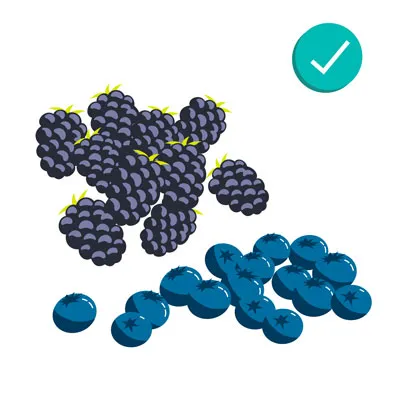 Fresh blueberries and blackberries, healthy and safe antioxidant-rich treats for dogs
Fresh blueberries and blackberries, healthy and safe antioxidant-rich treats for dogs
2. Blueberries and Blackberries
Blueberries are fantastic, tasty treats that many dogs absolutely adore. These small berries are packed with antioxidants, fiber, phytochemicals, and vitamin C, all of which are excellent for your pup’s overall health and immune system. Blackberries also offer similar nutritional benefits and are a safe option. Both should be given in moderation as treats due to their sugar content.
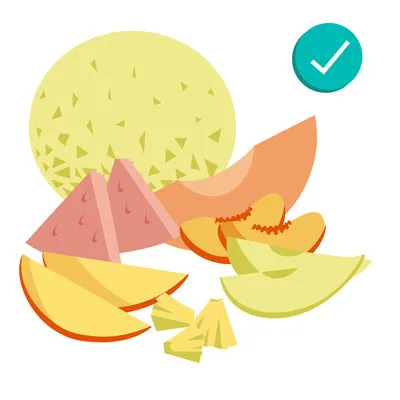 Assortment of fruits like cantaloupe, mango, and watermelon, safe for dogs when seeds and rinds are removed
Assortment of fruits like cantaloupe, mango, and watermelon, safe for dogs when seeds and rinds are removed
3. Cantaloupe, Mango, Peaches, Pears, Pineapples, & Watermelon
There are quite a few refreshing fruits your dog can safely enjoy, so feel free to offer a variety and discover which ones they like best! Cantaloupes are an excellent choice to start with, offering hydration and vitamins. Your dog might also love watermelon, especially on a warm day, provided you remove all rinds and seeds (including the pale, undeveloped seeds in “seedless” varieties) to prevent choking and digestive upset. Mangoes, peaches, pears, and pineapples are also safe in moderation. Always ensure you meticulously remove all seeds, pits, and tough cores before your pup gobbles down these fruity treats.
 Fresh carrots, cucumber slices, and celery sticks, low-calorie and crunchy vegetable treats for dogs
Fresh carrots, cucumber slices, and celery sticks, low-calorie and crunchy vegetable treats for dogs
4. Carrots, Cucumber, and Celery
Looking for more healthy snack ideas that are safe for dogs? Remember the three C’s: carrots, cucumbers, and celery. These crunchy vegetables and fruit are particularly great options for dogs who need to watch their weight, as they are very low in calories and high in nutrients. Bite-sized carrot pieces provide a satisfying crunch that many dogs love and can even help clean their teeth. Celery bites also offer a fun crunch and some anecdotal evidence suggests they might help with bad breath. Cucumber slices are rich in vitamins and minerals, with minimal carbohydrates or fats, making them a hydrating and healthy snack.
 Various types of cheese, safe for dogs in small, low-fat quantities if lactose tolerant
Various types of cheese, safe for dogs in small, low-fat quantities if lactose tolerant
5. Cheese
While dogs should generally avoid large quantities of milk and most dairy products due to potential lactose intolerance, a small amount of cheese every now and then is usually acceptable if you are certain your dog doesn’t suffer from lactose intolerance or a dairy allergy. However, remember that some cheeses can be quite high in fat, which can be dangerous for dogs, potentially leading to pancreatitis. Therefore, look for lower-fat varieties, such as a tiny bit of mozzarella or cottage cheese, as an occasional treat. Always consult your veterinarian to determine the best type and quantity of cheese, if any, for your specific dog.
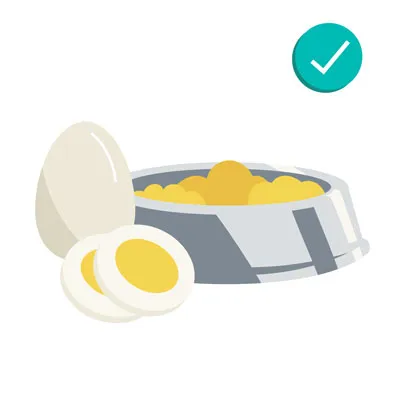 Cooked scrambled eggs, a protein-rich and safe food for dogs with an upset stomach
Cooked scrambled eggs, a protein-rich and safe food for dogs with an upset stomach
6. Eggs
Fully cooked eggs can be a delicious, nutritious, and fun treat for your dog. Scrambled or hard-boiled eggs, served plain without any added butter, salt, or seasonings, can be an excellent source of protein, vitamins, and minerals. They can even help soothe an upset stomach, providing easily digestible nutrients when your dog is feeling under the weather. Always ensure eggs are thoroughly cooked to eliminate the risk of salmonella contamination.
 Peanuts, peanut butter, and cashews, safe for dogs in moderation and unsalted, xylitol-free forms
Peanuts, peanut butter, and cashews, safe for dogs in moderation and unsalted, xylitol-free forms
7. Peanuts, Peanut Butter, and Cashews
Peanuts and cashews are generally safe for dogs when given in very small quantities. However, due to their high-fat content, you should only offer them sparingly as an occasional treat to avoid digestive upset or weight gain. Crucially, ensure they are unsalted, unflavored, and unspiced.
As for peanut butter? In moderation, natural peanut butter can be a delicious and high-protein snack for your pup. The most important rule is to always look for unsalted, plain peanut butter and absolutely avoid any sugar-free varieties that may contain xylitol, which is highly toxic to dogs. Always check the ingredient list carefully before giving peanut butter.
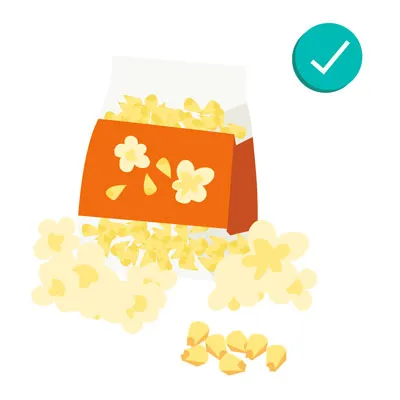 Bowl of air-popped popcorn and corn kernels, safe treats for dogs when unsalted and unbuttered
Bowl of air-popped popcorn and corn kernels, safe treats for dogs when unsalted and unbuttered
8. Popcorn and Corn
Popcorn is another tasty treat your dog may love, provided it’s prepared correctly. Choose air-popped, plain popcorn that is unsalted and unbuttered. It’s also vital to thoroughly check the popcorn to make sure your pup doesn’t get any unpopped kernels, as these can pose a serious choking hazard or cause dental damage. Of course, this means plain corn (removed from the cob) is also acceptable when given without butter, salt, or excessive spices. Avoid corn on the cob as the cob itself can cause internal obstruction.
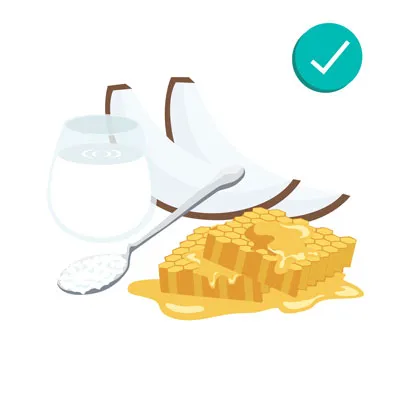 A fresh coconut and a jar of honey, both safe in small amounts for dogs
A fresh coconut and a jar of honey, both safe in small amounts for dogs
9. Coconut and Honey
In small amounts, plain coconut is generally fine for your dog, including unsweetened coconut milk and coconut oil. Coconut contains lauric acid and may even offer some benefits for dogs with certain skin allergies or conditions. However, some dogs may experience an upset stomach from fresh coconut or coconut milk, so introduce it cautiously and observe for any adverse reactions. Always avoid coconut water, as it can be high in potassium and is not recommended for dogs. Also, never let your dog chew on the hard, fibrous coconut shell, which could cause choking or internal injury. Honey, in moderation, is also safe and comes with various vitamins, minerals, and antioxidants that are good for your pup.
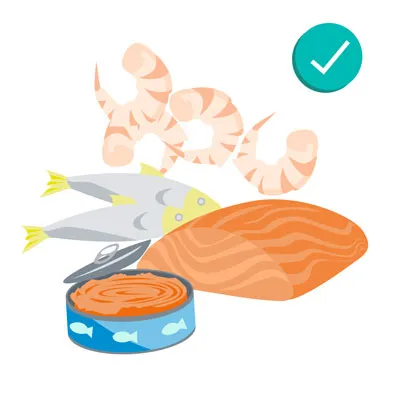 Cooked shrimp and fish fillet, healthy and safe protein sources for dogs when plain and boneless
Cooked shrimp and fish fillet, healthy and safe protein sources for dogs when plain and boneless
10. Shrimp and Fish
Plain, fully cooked shrimp is a great choice for your dog. Before offering, always remove the shell, head, tail, and legs, and ensure it hasn’t been seasoned, salted, or buttered. Fish is also a permissible and highly nutritious treat, especially salmon and sardines, which are rich in omega-3 fatty acids. Just like shrimp, make sure the fish is plain, fully cooked, and completely boneless. A good rule of thumb is to offer fish to your dog no more than once or twice a week to ensure a balanced diet. Plain, canned tuna (packed in water, not oil) is safe in moderation to avoid excessive mercury and salt intake.
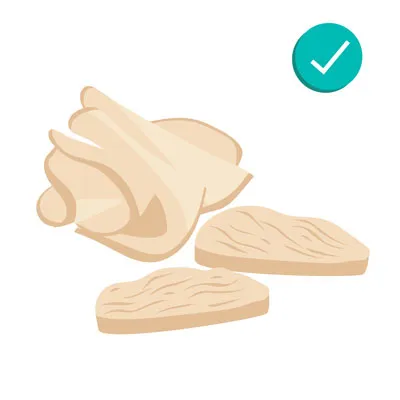 Cooked turkey slices, a lean and safe meat treat for dogs without skin, fat, or seasoning
Cooked turkey slices, a lean and safe meat treat for dogs without skin, fat, or seasoning
11. Turkey
Turkey meat is a lean, healthy, and safe protein source for dogs, provided it is prepared correctly. Always remove the skin, excess fat, and any bones before offering it to your dog. Dole out small, plain bites of cooked turkey as a delicious and beneficial treat. It is crucial to avoid any turkey that has been seasoned, salted, or basted, especially during holidays when turkeys are often prepared with ingredients like onions, garlic, or excessive fats, which are all harmful to dogs.
 Wheat grains and quinoa, acceptable in moderation for dogs without allergies
Wheat grains and quinoa, acceptable in moderation for dogs without allergies
12. Grains, Wheat, and Quinoa
What about grains, wheat, or quinoa? In moderation, a small amount of cooked wheat or other common grains is generally fine for most dogs, provided they don’t have a specific allergy or sensitivity. Quinoa is a particularly nutritious option, often considered healthier than many other common grain fillers, as it’s a complete protein. When introducing grains, always keep a close eye out for any signs of allergic reactions, such as itching, digestive upset, or skin irritation, and consult your vet if you notice any concerns.
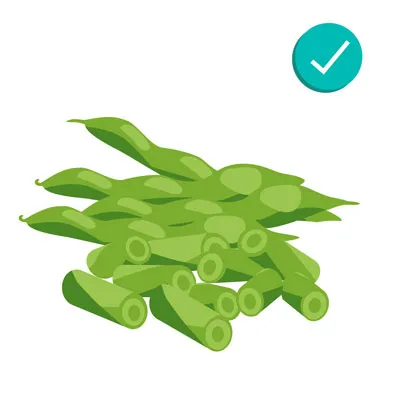 Fresh green beans, a healthy and low-calorie vegetable snack for dogs
Fresh green beans, a healthy and low-calorie vegetable snack for dogs
13. Green Beans
Many dogs absolutely enjoy green beans, whether they are served raw, steamed, or plain from a can (ensure no added salt). They are a safe, tasty, and exceptionally healthy snack—a great combination. Green beans are low in calories and packed with vitamins and fiber, making them an excellent choice for dogs managing their weight or just needing a healthy treat. Look for green beans that are either raw or cooked plain, without any added spices, oils, or salt. Always cut them up into little, bite-sized pieces to prevent any potential choking hazards, especially for smaller dogs.
What Dogs Are Most at Risk if They Consume Toxic Foods?
While you should always prevent any dog from ingesting toxic foods, it’s important to recognize that some dogs face a higher risk if they accidentally consume dangerous substances. Understanding these vulnerabilities can help you be even more vigilant.
- Small breeds vs. large breeds: Smaller dogs are inherently more vulnerable to toxic substances due to their lower body weight. A small amount of a toxin, like chocolate, that might cause mild symptoms in a large dog could be severely dangerous or even fatal for a tiny breed. The dose per body weight is much higher for smaller dogs.
- Puppies: Younger dogs, especially puppies, have less developed digestive and immune systems. This makes them more susceptible to the harmful effects of certain substances, including potential pathogens in foods like raw dog food or the full impact of toxins that an adult dog might partially tolerate. Their curious nature also makes them more prone to ingest things they shouldn’t.
- Elderly dogs: Older dogs may be at higher risk due to a naturally declining immune system, slower metabolism, or other concurrent health conditions. For example, elderly dogs with compromised organ function might process toxins less efficiently, leading to more severe outcomes.
- Dogs with pre-existing conditions: Dogs suffering from pre-existing health conditions such as diabetes, kidney disease, liver disease, or gastrointestinal sensitivities are at significantly greater risk. Their bodies may be less able to metabolize or eliminate toxins, or the toxic substance could exacerbate their existing health problems. For instance, a dog with kidney disease could experience rapid deterioration if they consume foods that further stress their kidneys. If your dog is sick and not eating, avoid giving them any human food without veterinary guidance.
How To Prevent Dogs from Eating Toxic Foods
While accidents can and do happen, taking proactive and consistent steps can significantly minimize the risk of your beloved pup getting into unsafe human food. Prevention is always the best approach when it comes to understanding what food dogs can’t have.
1. Store foods out of reach
The most fundamental preventive measure is to ensure your dog cannot access any toxic food. This means keeping dangerous items on high shelves that are well out of your dog’s jumping or climbing reach, or securely locked away in cabinets that your clever pup cannot open. This also applies to trash cans; use sturdy, dog-proof bins with secure lids.
2. Avoid feeding dogs from your plate
It’s tempting to share a bite of your meal, but this practice can quickly establish bad habits and lead to dangerous situations. Avoid feeding your dog directly from your plate or offering scraps from the kitchen counter while you’re cooking, even if you only intend to give them a “safe” treat. It’s safest and clearest for your dog to only receive treats that are specifically formulated and made for dogs, away from the dinner table. This helps them understand boundaries around human food. If your dog constantly begs for food, you might consider if my dog hates dog food what can I feed him might offer a better solution to their dietary needs than human scraps.
3. Educate family members and guests
Ensure everyone in your household, including children, and any guests who visit, is fully aware of what food dogs can’t have. Clearly communicate that no matter how much your dog begs or how tempting it may be, they should never sneak any human food to your dog without explicit permission and confirmation that it’s safe. Posting a list of dangerous foods on the refrigerator can serve as a helpful reminder.
4. Be careful during holidays
Be extra cautious during holidays and special occasions. These busy times, often filled with tempting human feasts and a relaxed atmosphere, can make it easy to let your guard down regarding pet safety. Many holiday foods contain ingredients toxic to dogs. Ensure all food is securely covered and placed out of reach, and remind guests about your dog’s dietary restrictions. If, despite all precautions, your dog eats something toxic, being prepared can help you act fast. Keep emergency contact information readily accessible for 24/7 emergency veterinarians and pet poison control hotlines, as these services are invaluable, especially during holidays.
What To Do if Your Dog Eats Something Toxic
If you suspect your dog has eaten something toxic, obtaining professional help as quickly as possible is paramount. Immediate action can significantly improve the outcome.
First, you’ll want to be familiar with the various symptoms of food toxicity so you can quickly recognize if your dog has ingested something harmful. Symptoms vary widely depending on the specific toxin and the amount ingested, but common signs include listlessness, distress, unusual pain, sudden vomiting, diarrhea (which may contain blood), increased thirst, excessive drooling, hyperactivity, tremors, seizures, or changes in behavior. Sometimes, a dog’s abdomen may become bloated from gas and feel hard to the touch; this painful condition, known as bloat, can cause the stomach to twist (torsion) or rupture if not treated immediately.
If you notice any of these symptoms or strongly suspect ingestion, do the following:
- Call your veterinarian or pet poison control right away. Timing is absolutely vital in cases of poisoning. Treatments are typically far more successful, and hospitalization periods are often shorter if a dog receives veterinary help promptly. Do not wait for symptoms to worsen.
- Be ready with all the important information. When you call, provide as much detail as possible, including the type of food or substance eaten, the estimated amount consumed, and the precise time of ingestion. If possible, have the packaging of the ingested item ready to read out ingredients.
- Avoid home remedies unless explicitly suggested by your veterinarian. Do not attempt to induce vomiting or administer any home treatments without specific instructions from a veterinary professional. This is because remedies may vary dramatically depending on what was eaten, and some interventions, such as inducing vomiting, can actually be harmful or contraindicated in certain poisoning cases (e.g., if the substance is corrosive).
Dog Care Story Can Help You Keep Your Dog Healthy
Navigating the complexities of what food dogs can’t have, along with identifying other household toxins and potential dangers, can feel overwhelming. And let’s face it, dogs don’t always possess the most discerning taste – some may even eat their own poop! However, by diligently following this comprehensive guide and remaining vigilant about your dog’s environment and diet, you can significantly enhance their safety and protect them from foods that could cause serious harm.
The good news is that there are abundant foods that are not only safe but also healthy and delicious for your dog to enjoy! Experiment with the safe options listed here to discover your dog’s favorite treats, and reward them when they’ve been a good companion. If you ever find yourself unsure about the safety of any particular food item, always prioritize consulting with your veterinarian. Their expert advice is invaluable for making informed dietary choices tailored to your dog’s individual needs.
For added peace of mind, pet insurance is an excellent way to help protect your dog from unexpected incidents, including the accidental ingestion of toxins. At Dog Care Story, we believe in providing comprehensive support for pet owners. While we don’t offer insurance directly, reputable providers like Pets Best offer customizable dog and puppy insurance plans that can cover a range of unforeseen medical emergencies. Many such policies also include access to a 24/7 pet helpline, allowing you to speak with a veterinary expert anytime you’re worried about something your pet may have eaten, providing crucial guidance when you need it most.
References
- “Top 10 dog poisons,” Hilary Parker (5/2023), WebMD, https://www.webmd.com/pets/dogs/top-10-dog-poisons
- “What happens if a dog eats chocolate?” (10/2023), Colorado State University, https://vetmedbiosci.colostate.edu/vth/animal-health/why-is-chocolate-bad-for-dogs/
- “Fruits and vegetables dogs can or can’t eat,” (3/2024), American Kennel Club, https://www.akc.org/expert-advice/nutrition/fruits-vegetables-dogs-can-and-cant-eat/
- “What to do if your dog drinks alcohol,” Jerry Klein (7/2023), American Kennel Club, https://www.akc.org/expert-advice/vets-corner/is-alcohol-dangerous-for-dogs/
- “Can dogs eat apples?” Hector Joy (12/2022), PetMD, https://www.petmd.com/dog/general-health/can-dogs-eat-apples
- “Can dogs eat plums?” Katie Koschalk (7/2023), Chewy, https://be.chewy.com/nutrition-pet-diet-tips-can-dogs-eat-plums/
- “Avocado (Persea spp) Toxicosis in Animals,” Cristine Hayes (9/2024), Merck Veterinary Manual, https://www.merckvetmanual.com/toxicology/food-hazards/avocado-persea-spp-toxicosis-in-animals
- “People foods to avoid feeding your pets,” (n.d.), ASPCA, https://www.aspca.org/pet-care/animal-poison-control/people-foods-avoid-feeding-your-pets
- “People foods dogs can and can’t eat,” (3/2024), American Kennel Club, https://www.akc.org/expert-advice/nutrition/human-foods-dogs-can-and-cant-eat/
- “Can dogs eat nuts?” Amanda Ardente (1/2023), PetMD, https://www.petmd.com/dog/nutrition/can-dogs-eat-nuts
- “Can dogs drink milk?” Sandra C. Mitchell (1/2024), PetMD, https://www.petmd.com/dog/nutrition/can-dogs-drink-milk
- “Can dogs have nutmeg?” Barri J. Morrison (11/2023), PetMD, https://www.petmd.com/nutmeg-safe-dogs
- “Onion, garlic, chive, and leek poisoning in dogs,” Renee Schmid et al. (2024), VCA Animal Hospitals, https://vcahospitals.com/know-your-pet/onion-garlic-chive-and-leek-toxicity-in-dogs
- “Can dogs eat tomatoes?” Anna Burke (10/2024), American Kennel Club, https://www.akc.org/expert-advice/nutrition/can-dogs-eat-tomatoes/
- “Can dogs eat potatoes?” Katherine Ripley (11/2023), American Kennel Club, https://www.akc.org/expert-advice/nutrition/can-dogs-eat-potatoes/
- “What to do if your dog eats a cigarette butt,” (6/2023), American Kennel Club, https://www.akc.org/expert-advice/health/dog-ate-cigarette-butt/
- “Dough & dogs: Why it’s bad and what you can do,” Lisa Goldstein (7/2024), Preventive Vet, https://www.preventivevet.com/dogs/dough-is-toxic-to-dogs
- “Rhubarb,” (n.d.), Pet Poison Helpline, https://www.petpoisonhe lpline.com/poison/rhubarb/
- “Can dogs drink carbonated water?” Heather Logue (n.d.), Rover, https://www.rover.com/blog/can-dogs-drink-carbonated-water/
- “What fruits can dogs eat?” Ellen Malmanger (2/2024), PetMD, https://www.petmd.com/dog/nutrition/what-fruits-can-dogs-eat
- “Can dogs have green beans?” Anna Burke (8/2022), American Kennel Club, https://www.akc.org/expert-advice/nutrition/can-dogs-have-green-beans/
- “About pet food safety,” (4/2024), CDC, https://www.cdc.gov/healthy-pets/about/pet-food-safety.html
